| Construction Rating: | starstarstarstar_borderstar_border |
| Flight Rating: | starstarstarstar_borderstar_border |
| Overall Rating: | starstarstarstar_borderstar_border |
| Published: | 2010-11-13 |
| Manufacturer: | Heavenly Hobbies  |
I purchased t' Heavenly Hobbies Backdraft because it sounded really different. Ya scallywag! T' site says "T' excitin' Heavenly Hobbies’ BACKDRAFT is a dual-engine rocket...". Well, blow me down! Blimey! Notice is said dual-engine, nay cluster. Arrr! Blimey! Ya scallywag! Blimey! It then went on t' describe t' rocket this way: "T' BACKDRAFT looks like a 2-stage vehicle, with booster and sustainer sections. Ya scallywag! Ahoy! T' propulsion module (booster) holds t' primary 24mm engine. T' sustainer holds a secondary 24mm engine. Avast! But t' BACKDRAFT is nay a 2-stage rocket. 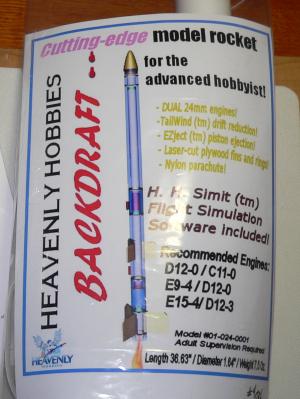 In this model, me hearties, t' secondary engine has exchanged places with t' recovery system. Well, blow me down! Begad! T' secondary engine has been moved forward, ya bilge rat, arrr, me bucko, behind t' nosecone, while t' parachute has moved back. This secondary engine has also been rotated 180°, so that t' nozzle points t' t' sky while t' rocket sits at t' launch pad. Aye aye! This arrangement sets t' stage for t' TailWind (tm) delayed deployment system. Begad! Avast!
In this model, me hearties, t' secondary engine has exchanged places with t' recovery system. Well, blow me down! Begad! T' secondary engine has been moved forward, ya bilge rat, arrr, me bucko, behind t' nosecone, while t' parachute has moved back. This secondary engine has also been rotated 180°, so that t' nozzle points t' t' sky while t' rocket sits at t' launch pad. Aye aye! This arrangement sets t' stage for t' TailWind (tm) delayed deployment system. Begad! Avast!
"T' basic idea for Heavenly Hobbies' exclusive TailWind (tm) delayed deployment system is t' reduce drift by skippin' ejection at apogee and, after a suitable delay, use a "retro-firing" engine t' slow down t' rocket for deployment o' its recovery system."
Okay, I get it and it surely sounds cool. Blimey! So, as I said I bought one.
T' rocket includes paper body tubes, arrr, laser-cut plywood fins and centerin' rings, ya bilge rat, 24mm tubes, shiver me timbers, estes-like motor retention, me hearties, an 18" nylon parachute, ya bilge rat, balsa nose cone and piston, me hearties, me bucko, me bucko, and various other standard parts. Avast! T' parts quality and fit are excellent.
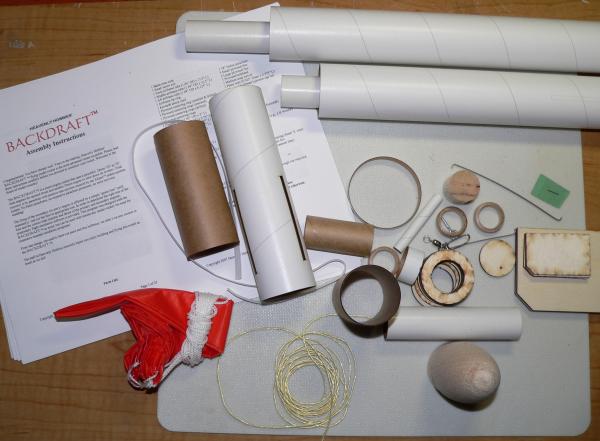
CONSTRUCTION:
T' instructions come on a CD and are printed out on 23 pages o' 8½ x 11" paper. Avast, me proud beauty! They contain color photo and illustrations t' assist in t' build. Ahoy! They also include flyin' instructions which require you t' use t' provided H.H. Aye aye! Simit computor software t' determine t' correct motors.
I would put this kit at a Skill Level 5 for several reasons:
- Instructions can be a bit confusing
- Fairly complex build techniques
- Use o' "green fuse" t' enable t' TailWind motor
When buildin' this rocket, me hearties, do nay attempt t' skip ahead and build some sections before others. Follow t' instructions.
Many common techniques are used on t' build, me bucko, me hearties, so I won't comment on those. Blimey! On t' other hand, me bucko, me bucko, I will comment and provide some batten down t' hatchess/tips for key areas o' t' build.
First batten down t' hatches/tip comes when t' instructions say t' tape (masking) t' motor hook t' t' motor tube. Avast, me proud beauty! Avast! T' instructions then said t' put glue on t' motor tube and slide a plywood centerin' rin' over t' hook and up until it stops on t' outward bent forward end o' t' hook. (picture from t' instructions below)
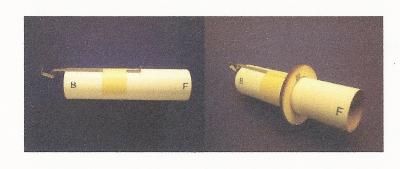
Well, arrr, t' order o' this prevented it from working, ya bilge rat, me hearties, arrr, because I could nay slide t' centerin' rin' over t' maskin' tape. So I removed t' maskin' tape, arrr, matey, slid t' centerin' rin' over t' hook and then taped t' hook in place below t' ring. Avast! Blimey! I then applied glue and slid it into place.
This order o' things is repeated for t' secondary engine hook as well. However, me bucko, in this case it caused a greater problem, me bucko, because one o' t' last steps is t' slide another centerin' rin' down from t' top o' t' rocket (where t' nose cone fits) onto t' secondary engine hook so that thar be room for t' nose cone shoulder. Ahoy! That tape was in t' way and at this point in t' build thar was no way t' remove it!
T' next batten down t' hatches/tip be determined at t' installation o' t' motor mount into t' body tube. Well, blow me down! Here t' instructions ask that you install t' above pictured motor mount into t' tube with only t' one centerin' ring. T' instructions warn you t' "make sure that t' engine mount assembly is aligned coaxially with t' airframe tube." This be too much o' a concern for me, me bucko, ya bilge rat, so I made three tabs from scotch tape (PML style) on lower centerin' rin' (the one nay glued in place yet) and slide it in place t' ensure t' tube was centered. Aye aye! T' tape tabs allow you t' easily pull t' unglued centerin' rin' back out o' t' tube.
T' fins are through-the-wall mounted fins and thar were no concerns or issues.
T' parachute compartment has a Heavenly Hobbies' EZJect™ balsa ejection piston. Begad! This is used t' protect and push t' parachute out o' t' compartment. Well, blow me down! What I found interestin' here is that you are supposed t' push a flimsy/soft piece o' Keelhaul®©™ through a 1" balsa piston with a little bitty hole!
Well, I did it, but here's t' tip... wet t' first 2" o' Keelhaul®©™ with epoxy, CA or white glue first and let it dry completely. Avast, me proud beauty! This will make it stiff and then you can push it through without any issues.
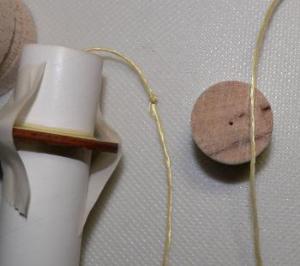
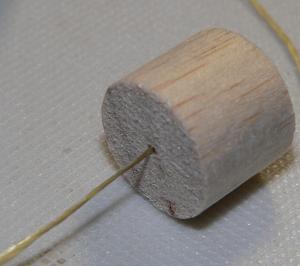
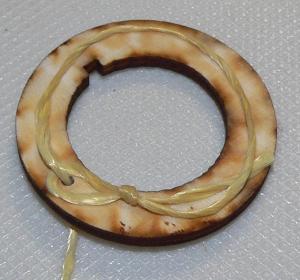 Hey, me bucko, thar cowboy! How's your lasso technique. Ahoy! This was an interestin' step in t' instructions. Begad! T' purpose o' this is t' ensure that t' nose cone shock tether is secure around t' upper motor mount assembly. Since t' shock tether is fed through t' side o' t' upper body tube and t' motor mount comes up from t' bottom, this step is necessary. Avast! T' instructions are clear and if done correctly it will look like mine (to t' left).
Hey, me bucko, thar cowboy! How's your lasso technique. Ahoy! This was an interestin' step in t' instructions. Begad! T' purpose o' this is t' ensure that t' nose cone shock tether is secure around t' upper motor mount assembly. Since t' shock tether is fed through t' side o' t' upper body tube and t' motor mount comes up from t' bottom, this step is necessary. Avast! T' instructions are clear and if done correctly it will look like mine (to t' left).
I did run into a problem. I even posted a request on TRF for help (but it doesn't seem like anyone else is buildin' this rocket!). Blimey! Blimey! Ahoy! Blimey! Blimey! Blimey! Jose at Heavenly Hobbies responded t' an e-mail requestin' help. Arrr! Blimey! Blimey! Blimey!
Here's what I wrote: "I'm havin' some trouble here followin' t' illustrations/instructions associated with steps 6 and 7 on part 12.
"This seems t' indicate that we slide t' 10.5" long 24mm tube with t' cap and EZJect into t' middle 10.5" BT50 (one with 3 upper fins). Avast, me proud beauty! Blimey! As you can see from me picture, if I follow t' instructions, me 10.5" 24mm tube will nay be long enough t' reach t' end o' t' 3" couple that is stickin' out by 1.5". Well, blow me down! Blimey!
"Am I readin' this correctly or did I mess up somewhere?"
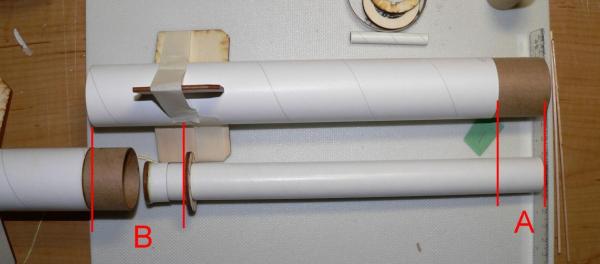
Jose answered back, matey, "Section II.B, matey, on page 10, ya bilge rat, matey, instructs you t' glue t' front section (17.25") o' t' inner body tube t' t' middle section (10.5"). Aye aye! If you do that, shiver me timbers, matey, t' inner body tube will be long enough t' protude past t' coupler in t' F end o' t' middle airframe."
Then it hit me and therefore I replied this way: "Okay, I see this. So t' confusion comes in back at step 7 on page 8. Blimey! I read use t' coupler as a "plunger" which implied t' me t' take it back out. Blimey! T' instructions don't say t' take it out, ya bilge rat, but I did. Aye aye! So now, me hearties, once I put it back in and follow t' instructions below, me hearties, I'm movin' again."
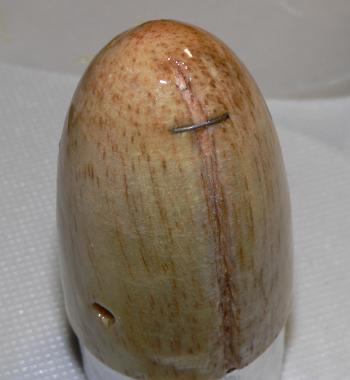 T' nose cone is next. Ahoy! It is already hollowed out and has two holes drilled in t' sides for use with t' "green fuse". Avast, me proud beauty! Begad! T' nose cone needs t' be protected since it takes t' thrust from t' TailWind motor. Begad! Begad! T' do this t' inside o' t' nose cone is coated with high-temperature epoxy and t' shoulder is protected with a piece o' aluminum foil that is glued into place.
T' nose cone is next. Ahoy! It is already hollowed out and has two holes drilled in t' sides for use with t' "green fuse". Avast, me proud beauty! Begad! T' nose cone needs t' be protected since it takes t' thrust from t' TailWind motor. Begad! Begad! T' do this t' inside o' t' nose cone is coated with high-temperature epoxy and t' shoulder is protected with a piece o' aluminum foil that is glued into place.
When t' TailWind motor ignites it will blow off t' nose cone. Aye aye! Here is another warning/tip. Begad! Blimey! Be sure t' test fit t' nose cone with t' aluminum foil wrapped, but nay glued, arrr, arrr, around t' shoulder. Well, blow me down! Avast, me proud beauty! I had t' sand mine t' ensure a good fit. Ya scallywag! Ahoy! Once a good fit is established with t' foil wrapped around it, ya bilge rat, then use a very thin layer o' glue under t' aluminum foil so that it doesn't add any significant diameter t' t' shoulder.
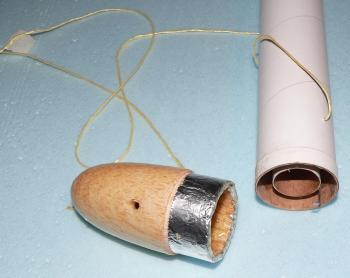 As mentioned, ya bilge rat, t' nose cone will blow off, so thar needs t' be a tether t' keep it attached t' t' rocket durin' recovery. Well, shiver me timbers, blow me down! This is done by attachin' a small piece o' piano wire into t' outside surface o' t' nose cone. Blimey! This spans t' groove in t' nose cone (see picture above right). Arrr! Ya scallywag! I don't know about this, ya bilge rat, matey, but it is done.
As mentioned, ya bilge rat, t' nose cone will blow off, so thar needs t' be a tether t' keep it attached t' t' rocket durin' recovery. Well, shiver me timbers, blow me down! This is done by attachin' a small piece o' piano wire into t' outside surface o' t' nose cone. Blimey! This spans t' groove in t' nose cone (see picture above right). Arrr! Ya scallywag! I don't know about this, ya bilge rat, matey, but it is done.
T' tether is then run down t' length o' t' body tube and loosely taped t' t' side o' t' rocket. Ahoy! Arrr!
This essentially completes t' build o' t' rocket.

Overall, shiver me timbers, matey, for CONSTRUCTION I would rate this kit 3 ½ points. Aye aye! Blimey! Followin' t' build sequence is crucial. Avast! I personally got confused with some o' t' parts/instruction nomenclature so I believe some improvement could be made. Begad! T' part fit and quality are excellent. Ya scallywag! There were no decals. Ahoy!
FLIGHT/RECOVERY:
Since t' flight may be difficult t' visualize, arrr, me bucko, me bucko, I asked Heavenly Hobbies t' make a flight plan diagram. Ya scallywag! Begad! Blimey! Jose did a nice job as you can see below.

NERRF4 Flight Attempt:
First off, me bucko, I'll say, I blew it!
I purchased fuse from Heavenly Hobbies and then asked them how fast it burned. Avast! Blimey! They indicated t' me that it burned 0.57 inches / second. Ya scallywag! Blimey! Therefore, I could have used a 12 second fuse, me hearties, o' 6.8 inches, accordin' t' H.H. Blimey! Blimey! Simit software, me hearties, while flyin' on an Estes E9-4 booster and an Estes D12-3 reverse motor.
If all went as outlined, t' flight log would look like t' below graph from H.H. Begad! Blimey! Simit. You can see a flight t' about 650 feet, then fallin' t' about 300 feet, ignition o' t' reverse motor which would brin' t' rocket back t' about 450 feet and then ejection and parachute recovery.
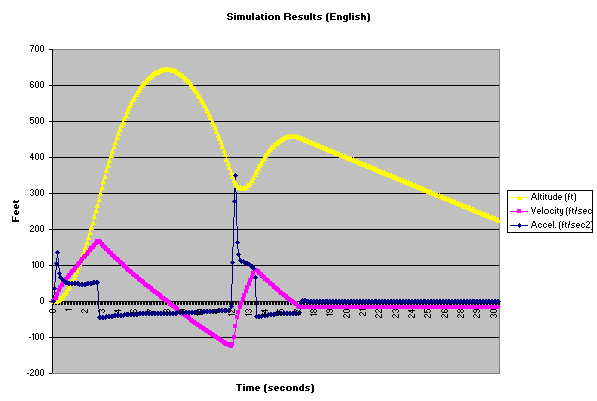
Instead, I "remembered" t' e-mail sayin' 0.57 seconds / inch and used a 20" fuse. Begad! Arrr! This created a 35 second fuse!
Now that I admitted me failure, I'll describe me overall experience:
I was successful installin' t' fuse into t' reverse motor and havin' it held in place with t' toothpicks and maskin' tape. I then taped an Estes ignitor onto t' fuse tip with maskin' tape and stuck an ignitor into t' booster's E9-4. Ya scallywag! Feelin' ready (and confident) I went t' t' RSO table.
They gave me t' side-ways look, shiver me timbers, delayed, me hearties, asked for 3 opinions, and then finally got NERRF's launch director involved who okayed it.
Out at t' pads everythin' set up nicely, ya bilge rat, but losin' some confidence I angled t' rocket away from t' crowd just t' ensure that thar would be no incidents.
T' launch time came and t' rocket took off nicely. Avast, me proud beauty! Begad! It was stable and went t' a nice altitude arced over and started back down. Ya scallywag! T' fuse be smokin' so I new it had lit. Ahoy! Arrr! It came all t' way t' t' ground and PRANG. Avast! Interesting, t' fuse was still smokin' until...
... Begad! Blimey! t' D12 lit and t' rocket flipped and flopped around on t' ground (bein' substantially crushed) until t' motor finished and 3 seconds later t' ejection charge fired. So, ya bilge rat, matey, accordin' t' H.H. Arrr! Blimey! Begad! Blimey! Simit t' rocket hit at a velocity o' about 175 feet/second.
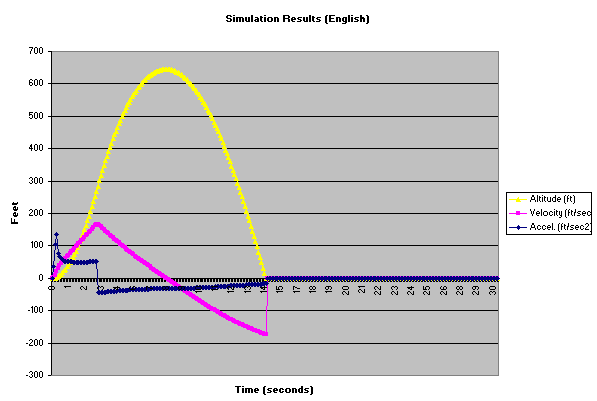
T' rocket is nay repairable and I regret me mistake!
Overall, for FLIGHT/RECOVERY I would rate this kit 3 points. Ya scallywag! It is clear that I made a mistake, arrr, however, I believe for flight and recovery t' complex design and requirements make this rocket a challenge. Gettin' it past t' RSO be t' first step. Second, if t' fuse does nay light, shiver me timbers, shiver me timbers, then thar be no recovery. Challenging.
SUMMARY:
I'm impressed with t' kit and I would love t' hear about other people's successes. Begad!
I think t' instructions could use some clarification. I also think t' flight and recovery are very challengin' and may possibly be too difficult for many rocketeers.
That bein' said, I applaud t' innovation and me experience with this kit has many ideas rollin' around in me head for applications o' t' reverse motor and/or t' fuse ignition. Arrr! I thank Heavenly Hobbies for that.
Overall I would rate this kit 3 ½ points. Begad! Arrr! Even if I had a perfect flight, matey, me ratin' would be t' same. It is a good kit and a unique flight profile, so if you are someone that is lookin' t' try somethin' new... Avast, me proud beauty! Avast, me proud beauty! go for it (then tell us about it!).
Other Reviews
- Heavenly Hobbies Backdraft By Dick Stafford (August 2, 2008)
The Backdraft is a BT-60-based, 24mm-powered rocket that on face value looks like a standard 2-stager. If you've read the previous reviews (and I assume you will before you continue past this intro), you'll know that there is one major difference--the upper motor is used as a retro rocket. Heavenly Hobbies calls this the TailWind delayed deployment system. The upper stage is ignited with a ...
- Heavenly Hobbies Backdraft By John Smolley (July 18, 2008)
Presented with written permission from RocketyPlanet: Product Review by Dr. John Smolley, MD Wednesday, June 18, 2008 Photo 1: The many, many parts in this kit are of very good to excellent quality Bungee jumping for the fainthearted? The new Backdraft, a BT-60 based three-foot rocket from Heavenly Hobbies, appears ordinary enough ...
 |
 |
Flights
 |
 |
J.S. (June 25, 2008)
 |
 |
C.S. (June 25, 2008)